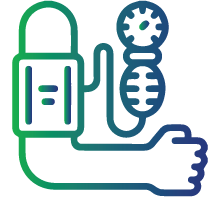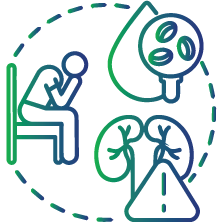
Preeclampsia Screening Test
About Preeclampsia Screening
Preeclampsia is pregnancy-induced hypertension (high blood pressure). After 20 weeks of pregnancy, it may have an impact on the liver, kidneys, and brain, among other body parts. It can cause major problems for you or your baby if left unchecked. Women who are at high risk for pre-eclampsia can be identified by screening, checking mean arterial blood pressure, the mother's medical history, and placental growth factor (PLGF) during the first trimester. Thus, getting your preeclampsia screening done is recommended for early detection and treatment of pregnancy-related complications
Symptoms of Preeclampsia
The common symptoms of preeclampsia include

Nausea or vomiting

Headache

Blurred vision

Pain in the abdomen

Difficulty in breathing

Low blood count

Changes in urine colour and frequency

High blood pressure

Swelling of face and feet

Pain in the region of the ribs
What does Preeclampsia screening include?
Preeclampsia can be detected early by regular prenatal check-ups. Your blood pressure is routinely checked during these prenatal visits for indications of high blood pressure, and a urine sample is examined for the presence of protein (Proteinuria). Preeclampsia screening includes:
Monitoring of Blood pressure:
-
Blood pressure is a measurement of the pressure exerted by the blood as it passes through the blood vessels or arteries
• Urine testing
-
For every antenatal check-up normally includes an examination of routine urine samples, to assess how effectively the kidneys are functioning; your doctor may request a 24-hour urine sample or a single urine sample
Blood test:
-
Your doctor may suggest a blood test to help rule out pre-eclampsia if you are between 20 and 35 weeks pregnant and they suspect you may have it. Blood tests also evaluate the functioning of the liver, kidney and total platelet count
Pregnancy ultrasound:
-
The growth of your baby will likely be closely monitored by your primary care physician, usually through ultrasound. It estimates the baby’s weight and volume of fluid in the womb through the ultrasound examination
Biophysical profile or a non-stress test
-
is a quick process that determines how your baby's heart rate responds to movement
Who should get screened for Preeclampsia?
Preeclampsia screening is recommended to be performed frequently for a pregnant woman who is at increased risk of developing high blood pressure-related complications. The following factors can increase the risk includes:

Being older than 40 years

First pregnancy

History of high blood pressure

History of diabetes

Chronic kidney diseases

Being Overweight

Family history of preeclampsia

Suffering from autoimmune diseases

Expecting twin babies
Preparation for Screening
No special preparation is required for preeclampsia screening
Interpretation from the Screening
· If the systolic pressure is 140 mm Hg or higher, and diastolic pressure is 90 mm Hg or higher, it is considered to be high blood pressure in pregnancy. Your doctor may recommend further testing if you have the high blood pressure to look for other preeclampsia symptoms.
· A dipstick (simple test for the detection of protein in the urine) when treated with a laboratory reagent it changes the colour of urine in the presence of protein in the urine.
· Blood test detects the amount of a placental growth factor protein (PIGF). If your PIGF levels are high it means that you do not have pre-eclampsia. Blood tests also evaluate the functioning of the liver, kidney and total platelet count.
· Pregnancy ultrasound and biophysical profile measure the overall health of your baby's respiration, muscle tone, movement, and amniotic fluid volume.
FAQs
What is the importance of preeclampsia screening?
In order to screen for preeclampsia, blood pressure readings may be taken. Preeclampsia screening may enable early detection and diagnosis of the condition, which helps in monitoring and providing efficient treatment to avoid pregnancy-related major problems
What is the effect of preeclampsia during pregnancy?
Preeclampsia frequently goes undetected until an unexpected blood pressure reading and urine test reveal it. In situations like this, the baby is delivered, the mother is monitored, and sent home as usual.
If preeclampsia develops early in the pregnancy or in a woman who already had high blood pressure before becoming pregnant, the effects are more severe. In order to maintain blood pressure under control, healthcare professionals could advise taking time off from work, bed rest, medication, or even hospitalisation. For the baby's long-term health, it is preferable to keep the foetus as long as feasible, assuming growth continues
When does preeclampsia occur during pregnancy?
Preeclampsia can develop at any point throughout pregnancy, delivery, and up to six weeks after delivery, but it usually does so in the third trimester and goes away within 48 hours of giving birth. Although the signs and symptoms may have gone unnoticed for weeks or months, preeclampsia can develop gradually or very rapidly, even worsening in a matter of hours
Is there are any chances of the reoccurrence of preeclampsia after delivery?
After experiencing preeclampsia, a woman is more likely to experience it again during later pregnancy. The recurrence of preeclampsia in women with mild symptoms will be less when compared with the women who had preeclampsia with severe symptoms and delivered before 30 weeks of pregnancy
What is the available treatment for preeclampsia?
Preeclampsia now only has one "treatment," which involves delivering the baby and placenta. The mother and her unborn child are closely monitored when preeclampsia starts to manifest. There are drugs and treatments that could make the pregnancy last longer, improving the baby's chances of being healthy and surviving. Preeclampsia cannot be stopped once it has started. In some circumstances, regardless of gestational age, the baby must be delivered right away to save the life of the mother or the unborn child

